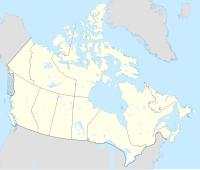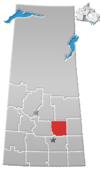Leross
Leross | |
|---|---|
Village | |
| Village of Leross | |
 Location of Leross in Saskatchewan | |
| Coordinates: 51°17′17″N 103°52′05″W / 51.288°N 103.868°W | |
| Country | |
| Province | |
| Region | Central |
| Census division | 10 |
| Rural Municipality | Kellross |
| Government | |
| • Type | Municipal |
| • Governing body | Leross Village Council |
| • Mayor | Francis Klyne |
| • Administrator | Elaine Klyne |
| Area | |
| • Total | 1.21 km2 (0.47 sq mi) |
| Population (2016) | |
| • Total | 46 |
| • Density | 38.0/km2 (98/sq mi) |
| Time zone | UTC-6 (CST) |
| Postal code | S0A 2C0 |
| Area code(s) | 306 |
| Highways | |
| [1][2][3][4] | |
Leross /ˈliːrɒs/ or /ləˈrɒs/ (2016 population: 46) is a village in the Canadian province of Saskatchewan within the Rural Municipality of Kellross No. 247 and Census Division No. 10.
History[]
Leross incorporated as a village on December 1, 1909.[5]
Demographics[]
In the 2016 Census of Population conducted by Statistics Canada, the Village of Leross recorded a population of 46 living in 22 of its 26 total private dwellings, a 19.6% change from its 2011 population of 37. With a land area of 1.21 km2 (0.47 sq mi), it had a population density of 38.0/km2 (98.5/sq mi) in 2016.[8]
In the 2011 Census of Population, the Village of Leross recorded a population of 37, a -11.9% change from its 2006 population of 42. With a land area of 1.21 km2 (0.47 sq mi), it had a population density of 30.6/km2 (79.2/sq mi) in 2011.[9]
Attractions[]
The Kellross Heritage Museum (1962–3) is a municipal heritage property on the Canadian Register of Historic Places, located within the village of Leross.[10]
See also[]
- List of communities in Saskatchewan
- Villages of Saskatchewan
References[]
- ^ National Archives, Archivia Net, Post Offices and Postmasters, archived from the original on October 6, 2006
- ^ Government of Saskatchewan, MRD Home, Municipal Directory System, archived from the original (– Scholar search) on November 21, 2008
- ^ Canadian Textiles Institute. (2005), CTI Determine your provincial constituency, archived from the original on 2007-09-11
- ^ Commissioner of Canada Elections, Chief Electoral Officer of Canada (2005), Elections Canada On-line, archived from the original on April 21, 2007
- ^ "Urban Municipality Incorporations". Saskatchewan Ministry of Government Relations. Archived from the original on October 15, 2014. Retrieved June 1, 2020.
- ^ "Saskatchewan Census Population" (PDF). Saskatchewan Bureau of Statistics. Archived from the original (PDF) on September 24, 2015. Retrieved May 31, 2020.
- ^ "Saskatchewan Census Population". Saskatchewan Bureau of Statistics. Retrieved May 31, 2020.
- ^ "Population and dwelling counts, for Canada, provinces and territories, and census subdivisions (municipalities), 2016 and 2011 censuses – 100% data (Saskatchewan)". Statistics Canada. February 8, 2017. Retrieved May 30, 2020.
- ^ "Population and dwelling counts, for Canada, provinces and territories, and census subdivisions (municipalities), 2011 and 2006 censuses (Saskatchewan)". Statistics Canada. June 3, 2019. Retrieved May 30, 2020.
- ^ Canadian Register of Historic Places.
Coordinates: 51°17′17″N 103°52′05″W / 51.288°N 103.868°W
- Villages in Saskatchewan
- Rural Municipality of Kellross No. 247
- Division No. 10, Saskatchewan
- Saskatchewan Division No. 10 geography stubs


